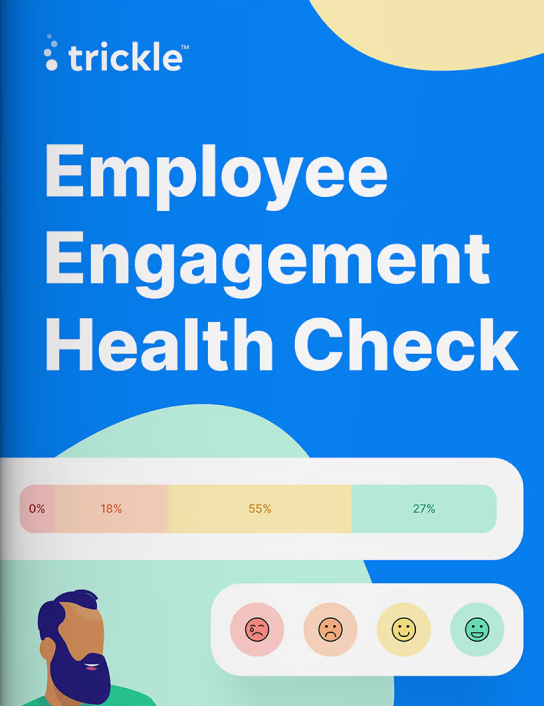How well does your company engage its employees?
Take your health check and find out.


Since March nearly half the UK workforce has been working remotely due to the Coronavirus. Now as the UK Government lays out its plans to ease the lockdown, a return to the workplace is imminent for many people across the country.
Transitioning the workforce back into their traditional work environment will be more complicated than just reopening doors. To ensure all goes well with this inevitable return, meticulous planning on the part of the organisation will be required to ensure its people feel secure and safe about returning to the office.
To achieve this transition safely and successfully, organisations will need to take on board and seriously consider their people’s physical safety and wellbeing.
To help you navigate this process Trickle has put together some tips we think will be useful when transitioning your people back to work post lockdown.
Tip 1 – Reinforce the Organisation’s Commitment to Safety
A ONS survey found that just over half of UK adults (53.1%) said they felt Coronavirus was affecting their wellbeing, with nearly half (46.9%) reporting high levels of anxiety.
Right now, people will be feeling very vulnerable and it is important you share with them what steps you are taking to safeguard their health and how you are following government guidance.
Active two-way engagement will help to alleviate some of this uncertainty and anxiety and should also help boost their sense of wellbeing.
Your people need to know that their health, safety and overall wellbeing are your top priority. Accurate information and updates about your health and safety protocols must be clear and readily available to all employees.
You can also share relevant and fact-based information with them through discussion and at the same time encourage them to seek further information from trusted sources such as the World Health Organisation.
It is worth noting that lockdown easing measures could potentially be reversed at short-notice. This means that good organisations should have a prepared action response plan and a real-time strategy that can deal with these sudden changes.
Trickle’s Shout About feature is a great way for you to quickly raise group awareness about new policies or a change in safety protocols.
With an Employee Engagement platform like Trickle in place you will also be able to positively engage with your people, pro-actively address their concerns, help reduce their stress, show them they are valued and demonstrate to them that you are on top of the situation.
Tip 2 – Pro-actively Monitor How Your People Feel
The CIPD urges organisations to consider that some of their people who previously did not have any mental or physical health issues may have experienced challenges during lockdown and need to be able to discuss these changes.
It is in everyone’s interests if an organisation can help its people overcome any issues in order to stay healthy and be able fulfil their role.
To do this, it is important an organisation checks-in and engages with its people in real-time to see how they are readjusting. An organisation needs to encourage people to raise their concerns, ask questions and make suggestions.
Trickle’s Moodsense™ feature will provide you with a quick overview of your people’s feelings giving you a general idea of how a workforce is responding to your actions and any other changes.
It might also be useful to remind anxious employees of the availability of an employee assistance program. Also, ensure your people have a way to request more one-to-one support. This proactive approach can help you resolve smaller issues before they become bigger problems.
Trickle’s Confide package allows your people to privately raise more delicate topics with you (such as anxiety) and gives them the option to do it anonymously if they wish to do so.
Your people’s real-time feedback will provide you with accurate insights into what is important right now and also give you the opportunity to respond quickly and find the right solutions to create the best outcomes for an all-round better Employee Experience.
Tip 3 – Consider Letting People Continue to Work Remotely
A recent study from ENGAGE and YouGov found that 55% of respondents (furloughed, remote workers, currently remote working) were not comfortable with the idea of going back to work.
51% said their biggest concern was over how social distancing measures could be effectively implemented. Moving around the workplace, using communal areas, and commuting were among the worries cited by respondents who said they feared they could be infected.
Aside from health concerns, 42% of people said they felt that returning to a physical workplace will see a deterioration in their work-life balance, while one third predicted a decline in mental health.
A study by Hitatchi Capital of over 1,800 UK adults found across different employee sectors people do not want to return to the old system. 41% cited the time, cost savings and not having a daily commute as the main reasons for wanting to work from home.
However, organisations must also consider that their people’s domestic situations may have altered in ways that impact their ability to fulfil their role e.g. no available childcare and vulnerable dependents. It is vital leaders are sensitive to this and make accommodations and offer support where possible to reduce the stress their people may be going through.
To minimise onsite headcount, alleviate their people’s safety concerns and reduce the strain on their people organisations should consider allowing people to continue to work from home and thereby lessen the risk to their health.
Major organisations such as Facebook and Google have extended their working from home polices until next year, while Twitter has announced it has given its staff the option to work from home forever if they want to.
Be Understanding
As with any period of change, organisations need to understand that their people will all experience the pandemic differently and will require different levels of support to protect their wellbeing and engagement.
Not everyone has been impacted by the virus equally, some who have faced particularly challenging situations such as financial worries, childcare issues, illness and overworking may require extra support from you as they return to work.
It is likely that your people will need a period of adjustment so that they can be re-orientated and re-introduced to the new world of work.
It is therefore important your workforce is given a channel to reach out or voice their concerns as they need to and, they receive a response as soon as reasonably possible. Open two-way conversation will help to alleviate stress and give an organisation the opportunity to understand important insights on how they can adapt to help their employees.
Contact us now to find out how Trickle’s Real-Time Employee Wellbeing and Engagement platform can help you support your people through this transitional period.